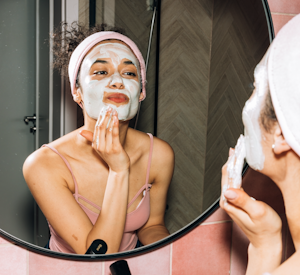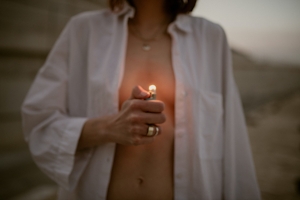
Take your skincare routine into your own hands with this CBD lotion recipe. (Photo by Jonathan Coward/HERB)
CBD Lotion Recipe: How to Make CBD Cream At Home
CBD topicals have incredible benefits for the skin from anti-aging to anti-inflammatory properties. But did you know you can make them at home? This CBD lotion recipe will teach you how, step-by-step.
Natural skincare is a hot topic these days, and for good reason. The skin is the body’s largest organ. It provides the first line of defense against the environment, gives the body the ability to sense temperature, and protects it from potentially harmful pathogens and bacteria. With such big responsibilities, why not treat your skin to the ultimate botanical luxury—homemade CBD cream?
CBD salves and lotions are all the rage on the skincare scene. But, you don’t have to pay a fortune to reap the benefits of this potent natural medicine. Short for cannabidiol, CBD is a medicinal compound found in the cannabis plant. Sold around the U.S. and Canada as hemp oil supplements, this natural remedy may have some serious benefits for the skin, from treating inflammation to reducing acne.
And surprisingly, making your own lotions and creams is easy. After a little preparation, you can have a fresh batch of your very own infused topicals within an hour. Just follow Herb’s step-by-step guide below.
Benefits of CBD Lotion Recipe

Take your skincare routine into your own hands with this CBD lotion recipe. (Photo by Jonathan Coward/HERB)
With strong antioxidant and soothing properties, cannabis makes for an excellent addition to homemade skincare products. Whether you’re hoping to make your own homemade pain cream or simply want to take advantage of the herb’s rejuvenating nature, there are many reasons to add a little herb into your morning routine.
Anti-Aging CBD Cream
There are two primary types of skin aging: intrinsic and extrinsic. Intrinsic aging is inevitable, as the skin naturally changes with age. As you grow older, the skin becomes softer and you begin to lose collagen fibers and elasticity. While modern inventions like Botox and other skin care technologies seek to remedy the situation, those hoping to discover the fountain of youth may have to wait a while.
Extrinsic aging, however, is something that each individual can influence. Extrinsic aging refers to external factors like environment, pollution, UV radiation, and beauty routines. Over time, these outside factors can cause damage to the skin, leading to sunspots, redness, acne, and all-around wear and tear. It is impossible to avoid all forms of extrinsic aging, however, your daily care routine, lifestyle, and diet can all make a difference.
Extrinsic aging is where cannabis skincare comes in handy, especially creams and products infused with CBD. The cannabis compound is a potent antioxidant. In fact, a patent held by the U.S. government states that cannabinoids like CBD may be more potent antioxidants than vitamins C and E.
Antioxidants are natural remedies for free-radical damage. Free-radicals are produced naturally by the body and can contribute to aging over time. Free radicals, however, are also produced by exposure to pollution, UV radiation, and other toxicants that are now commonplace in daily life. Needless to say, exposure to too many free radicals does not make for healthy skin. The antioxidant potential of CBD may make it a wonderful tool for protecting skin as it ages.
CBD Cream for Inflammation
There is a growing body of evidence that suggests that cannabis compounds may pave the way for a new wave of anti-inflammatory drugs in the future. Early in 2018, researchers even found that CBD successfully eased inflammation in an experimental model of allergic dermatitis.
Simply stated, the cannabis compound reduced inflammation and swelling caused by an allergic rash. The study provided the first scientific evidence that CBD may be useful for the treatment of inflammatory skin conditions, easing discomfort and calming the immune system.
CBD Cream for Pain
CBD and other cannabis compounds are natural analgesics. As it turns out, these natural medicines may be particularly effective for easing symptoms of inflammatory pain. When applied topically, CBD lotions and body creams may be able to reduce pain in a localized region. Unlike consuming CBD oil orally, topical CBD does not penetrate the bloodstream.
Instead, the hemp oil works most of its magic on the surface of the skin. Many consumers with arthritic pain find that cannabis topicals are useful for easing pain and tension on joints. In these cases, topical CBD creams work best on joints that are closer to the skin, like the wrists, elbows, and knees. (Here’s Herb’s full explainer on the best CBD oil for pain.)
How to Make Your Own CBD Cream At Home

Photo by Jonathan Coward/HERB
This CBD body cream has a thick, whipped consistency and is ideal for dry and damaged skin. An ultra-moisturizing body lotion, this cream uses nutrient-dense shea butter to soothe and soften inflamed skin. It also contains aloe vera gel—which has long been used to help heal sunburns and ease irritation—and vegetable glycerine—which draws water to the skin and maintains hydration.
This CBD lotion recipe uses CBD oil, which can be purchased around the U.S. and Canada. However, those hoping to add some THC to the mixture can follow the exact same steps. If you already have your own cannabis-infused coconut oil for cooking, that same oil can be used in this recipe instead of concentrated CBD oil. Homemade skincare is incredibly versatile. Once you have a basic template down, you can easily make adjustments to fit your individual needs.
CBD Lotion Ingredients:
- ½ cup shea butter (preferably unrefined)
- ½ cup coconut oil
- ⅓ cup aloe vera gel
- 2 tbsp (⅛ cup) vegetable glycerine (optional)
- 2 tsp concentrated CBD oil or tincture
- Any fragrant essential oil
Cocoa butter can be used as an alternative to shea butter.
CBD Lotion Materials:
- Double boiler
- Measuring cups
- Measuring spoons
- Spoon
- Spatula
- Handmixer or blender
- Glass container
CBD Lotion Recipe:
- Measure all ingredients before beginning.
- Fill the bottom of a double boiler with an inch or two of water. If you do not have a double boiler, simply place a heat-proof bowl on top of a traditional cooking pot.
- Warm water over low to medium heat. Add the shea butter and coconut oil to the top of the double boiler.
- Gently melt the shea butter and coconut oil until there are no lumps, stirring frequently to combine the oils and prevent scorching.
- Once melted, turn off the heat and remove oils from atop the water. Transfer to a glass blender or heat-safe bowl.
- Allow the oil mixture to cool for at least one full hour, scraping down the sides of the bowl with a spatula if needed.
- Add aloe vera gel, vegetable glycerine, your desired amount of essential oil, and your desired amount of CBD oil.
- Use a hand mixer or blender to emulsify all ingredients and create a whipped consistency.
This recipe will keep for two weeks without refrigeration. For extended shelf life, consider adding vitamin E. This acts as a natural preservative. Extra lotion can be refrigerated for one month or longer in an air-tight container. Simply let the mixture cool to room temperature before use.
Troubleshooting your Homemade Cannabis Cream:
Making your own skincare can be tricky. The most common problem? Not achieving your desired texture. Here’s how to troubleshoot the most common problems when making your own CBD cream:
Gritty texture: Whip your CBD body cream longer and consider adding more vegetable glycerine one tablespoon at a time.
Too thick: Add more aloe vera gel one tablespoon at a time, continue whipping until the desired consistency is achieved.
Too thin: Remelt an even ratio of shea butter and coconut oil, allow to cool, and blend into mixture one tablespoon at a time.
Not potent enough: Add more of your favorite CBD or cannabis oil and whip.
How to Calculate the Dosage for your CBD Lotion Recipe

Photo by Jonathan Coward/HERB
If you’re using homemade cannabis cream to ease pain, muscle soreness, or inflammation, it may be useful to get a rough estimate of how much CBD or cannabis oil you are actually infusing into your lotion.
fourfivecbd offers an excellent example. The company was started by two professional rugby players, Dom Day and George Kruis. Without a doubt, these guys know a thing or two about using CBD topicals for recovery. The fourfivecbd Muscle Rub is uniquely formulated for pain, soreness, and inflammation. It also contains a carefully measured 300 milligrams of CBD isolate per container.
When making CBD skincare, it is best to start with a highly concentrated CBD oil or tincture. A highly concentrated solution will allow you to infuse more CBD without altering the consistency of the body cream.
The dosage of your DIY CBD cream will depend on the initial concentration of the CBD or cannabis oil.
Typically, CBD tinctures are measured in milligrams per milliliter. This recipe, however, uses cups and tablespoons. To get a ballpark idea of how much CBD is infused into your cream, you’ll have to do a little math.
If your dosage still is not strong enough after crunching the numbers, however, you may want to halve the contents of the primary oils in the recipe listed above in order to increase the concentration of CBD or cannabis oil in your end product.
The maximum yield of this recipe is about a cup and a half of CBD cream. However, the true yield of the moisturizer will likely be a little less. If you use 10 milliliters of a 37-milligram per milliliter CBD oil (about two teaspoons) in this recipe, a crude estimate places the dosage at approximately five milligrams of CBD per teaspoon of oil.
Yet, regardless of your end result, you can determine a ballpark estimate of the strength of your CBD cream by plugging in your specific numbers to the calculations here:
Step 1: Convert Cups to Milliliters
First, you need to convert the amount of lotion you have from cups to milliliters.
(Approximate amount of cups) X (0.236588 liters) X (1000 milliliters)
One and a half cups of lotion yields approximately 355 milliliters.
Step 2: Milligrams of CBD per Milliliter of Lotion
Next, you’ll need to figure out how many milligrams of CBD are in each milligram of lotion.
(Grams per milliliter of CBD Added X total milliliters added) ➗ (Total milliliters from step 1)
Step 3: Convert Milliliters to Teaspoons
It’s difficult to tell exactly how many milliliters of lotion you are spreading on your skin. So, for an easier visual, you can convert milliliters to teaspoons. That way, you can get a ballpark estimate of how much CBD you are actually applying to your skin.
(Answer from step 2) X (5 milliliters per teaspoon)
This will give you a rough total amount of CBD found in a teaspoon-sized dollop of your homemade CBD cream. However, it’s always best to assume that there is actually a little less than this, given that this simple math can only get you so far.
Herb Recommended Products:
READ MORE














